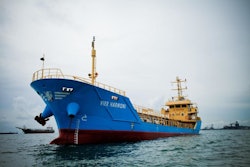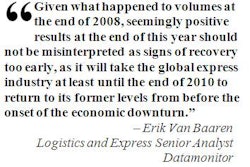
September 1, 2009 — Long-haul truck operations are the lifeline of Europe, the link that joins together the continent's various countries and permits trade between them. However, risks on the road have increased significantly over the past decade. Thefts from long-haul trucks total in the region of 8.2 billion euros every year. Now new initiatives are being taken to prevent these thefts, both by the EU and by Volvo Trucks.
An Ongoing Threat
According to the commercial drivers' International Road Transport Union (IRU), 17 percent of Europe's long-haul truck drivers are victims of robbery during work-hours at some time over a five-year period. The robberies often take place at pull-off areas called "lay-bys" in Europe. The thieves make off with everything from expensive electronic goods and tobacco to chocolate and shaving cream. According to Europol, goods to the value of about 8.2 billion euros are stolen every year in Europe. If all the peripheral costs are added in, such as repairs, replacement freight and police man-hours, the figure rises significantly.
"These attacks are a serious threat to the safety and security that commercial vehicle drivers have the right to enjoy in the pursuit of their profession," says Per-Anders Grösfjeld, marketing manager for transport information systems at Volvo Trucks. "They are also a threat to the haulage companies and the high-value goods for which they are responsible while carrying out their haulage duties. Ultimately, even the end customers suffer as a result of delays caused by vanishing cargoes."
It might be tempting to believe that Western Europe is a relatively safe place compared to other parts of the world, but Europol's statistics reveal that many parts of Western Europe are high-risk zones with regard to transport thefts, on a par with countries such as Russia, Mexico and Brazil.
Threat to the Supply Chain
About 10 years ago, the most common site of thefts in the transport chain was cargo terminals and warehouses. The solution was walls, fences and rigorous checks and controls, but that only meant that the problem shifted. Now it is the roads that have become the workplace of organized crime, and their victims are the long-haul trucks. It is out on the road that the cargo is by far at its greatest risk of being stolen, according to Europol.
The perpetrators are often international criminal organizations, but despite this, cross-border police cooperation has been rather ineffectual. Statistics on crimes against the transport industry are unreliable since the police do not regard transport as a separate category, nor do they coordinate actions against this new type of organized crime. However, in the wake of the skyrocketing increase in roadside piracy and the increasingly frequent violence used against drivers, the EU is now taking the initiative.
Anne E Jensen, substitute member in the EU Parliamentary Transport Committee, has been campaigning for a long time for the problem to be tackled with determination.
"The long-haul truck is a very vulnerable part of the transport chain, and that means, not least, a major risk for the drivers," she says, explaining that the increased risk level in the profession may cause fewer people to choose to become drivers. "And if road transport slumps, that's going to be a serious problem for growth and for society in general."
Keeping Drivers Safe
For the past few years no, Jensen and the EU have been working to build safe and secure truck stops for transport industry drivers. It is through SETPOS, a joint organization bringing together the various relevant parties, that roadside breaks are going to be made safer. The truck stop sites are fenced in and patrolled so that the drivers can sleep safely and soundly without having to worry about protecting their cargoes or being victims of violent crime.
At present there are five such truck stops. There are two in Germany, one in Britain, one in France and one in Belgium. "But more are on the way," says Jensen. "In Europe alone, at least 200 secure truck stops are needed."
Organized crime has discovered that roadside theft involves low risk but a potential for huge gain. That is why it is increasingly common for entire rigs to be hijacked, often at gunpoint. A big cargo is stolen quickly and easily, and in less than an hour the cargo can be reloaded onto other vehicles and vanish from the scene. The police have no chance of catching up. This is therefore an area that Volvo Trucks is addressing.
Volvo Trucks Steps up Efforts
As a truck manufacturer, Volvo is tackling the problem from the dual perspectives of the driver and the vehicle. In order to safeguard goods transport, Volvo Trucks has taken the first step by launching Security Service, a supplement to the Dynafleet transport information system in Europe. With this system, the truck is under constant surveillance. Working together with Securitas, Volvo Trucks offers subscribers a service whereby they can press an alarm button in an emergency situation to alert the police or Securitas personnel.
"However, there is so much more the industry has to do to tackle this problem seriously," says Jonas Thorngren, transport security expert at the Volvo Group. Together with an outside partner, Volvo Trucks is now developing a lockable "fifth wheel" which can be remotely controlled, thus preventing the trailer from being separated from the truck and disappearing.
The next stage in the security system provides protection from theft of the whole rig. With the help of a manual alarm or a system that triggers an alert as soon as the truck passes a predetermined geographic perimeter, it will be possible to either prevent the truck from starting after it stops or to gradually restrict its speed until it comes to a complete halt. Since the driver has no control over any part of this process, his or her safety is not jeopardized.
"Having said that, the solution lies in more than just technology. The driver's knowledge and his or her routines are immensely important," says Thorngren. According to a new EU directive, every driver must undergo at least 35 hours of training within a five-year period. Volvo Trucks has developed a training program that puts the focus on the driver's safety awareness. The spotlight is both on increasing know-how about crime situations and thus reducing the risk of being the victim of crime, and also reducing the risk level if anything goes wrong when you are the victim of a crime.
"When the criminals realize that the security systems surrounding the entire rig force them to take ever-larger risks, and the driver is in no personal danger him or herself, we feel that few criminals will feel it's worth the effort," says Thorngren.
SIDEBAR
A Driver's Lesson: "It's Important to Be Alert"
Hubert Seufert loves driving trucks and has been doing just that for 30 years. But after he was drugged and robbed at a truck stop in France a couple of years ago, he is more cautious.
"Today all truck drivers are in constant fear of being robbed," he says.
He woke up because it was so hot in his truck cab. It was difficult to breathe, airless. Seufert, who has not touched a drop of alcohol in years, says that it felt like he was suffering from a huge hangover. When he crawled out of the cab, he felt as though he had no real contact with his limbs; it was difficult to think properly. And there was a terrible smell in his nostrils.
"I wasn't a human being," he recalls. "It was as though the world around me didn't exist, and initially I didn't even notice my colleague who was standing outside my truck cab shouting 'I've been robbed, my boss is going to sack me.'"
A minute later Seufert discovered the hole cut into the side of his cargo platform tarp, and realized that he too had been the victim of robbery. The incident took place two years ago but Seufert remembers it all very clearly. How he suddenly snapped awake and rushed to the rear of his truck, only to be greeted by the broken seal and open doors. Five pallets of DVD players were missing.
It was 10 in the morning, and Seufert was already five hours late. Seufert, who says he has never overslept once in his life, realized that Philips in Germany was going to have to wait a long time for delivery of their cargo from the warehouse in France.
"I'd stopped at a lay-by on the border with Belgium to have a nap. Both my mobile phone and alarm clock were set to wake me up at five, but I heard nothing," he says.
The robbers apparently had sprayed gas through the side window that Seufert had left open to let in fresh air. When the French police arrived, they explained that he'd been lucky — it was his open window that ensured his survival. If the gas had not been diluted by the fresh air, he could have died inside his cab. Today Seufert says that his stomach still turns at the thought of what happened.
"I avoid sleeping in any lay-by without a security patrol, and to make things easier my boss has installed a climate unit on the roof of the cab so that the windows can stay firmly shut," he explains, adding that most drivers have been involved in incidents of one kind or another.
Seufert relates that he has colleagues who have been forced out of the driver's seat at gunpoint and had to stand helplessly by while their entire rig was hijacked, and that there is almost no truck driver who does not have a nagging sense of constant fear at the back of his mind.
Nowadays he makes sure that he always stops at refuelling stations with overnight facilities — so called "autohofs." He also makes sure he blocks the doors using a belt so that they cannot be opened from the outside. What is more, he does not like the cargo platform to be sealed since that only advertises that the truck is carrying a valuable load.
So what happened after the robbery? Philips received compensation through their insurance company, but Seufert says that he has no idea what happened with the robbers.
"I've no idea. I don't even know who they were, although I suspect a group of young lads who were hanging around in the lay-by. They were walking around asking all the drivers for food, but I suspect what they were really doing was to check out the cargoes. It's important to be alert," concludes Seufert.
An Ongoing Threat
According to the commercial drivers' International Road Transport Union (IRU), 17 percent of Europe's long-haul truck drivers are victims of robbery during work-hours at some time over a five-year period. The robberies often take place at pull-off areas called "lay-bys" in Europe. The thieves make off with everything from expensive electronic goods and tobacco to chocolate and shaving cream. According to Europol, goods to the value of about 8.2 billion euros are stolen every year in Europe. If all the peripheral costs are added in, such as repairs, replacement freight and police man-hours, the figure rises significantly.
"These attacks are a serious threat to the safety and security that commercial vehicle drivers have the right to enjoy in the pursuit of their profession," says Per-Anders Grösfjeld, marketing manager for transport information systems at Volvo Trucks. "They are also a threat to the haulage companies and the high-value goods for which they are responsible while carrying out their haulage duties. Ultimately, even the end customers suffer as a result of delays caused by vanishing cargoes."
It might be tempting to believe that Western Europe is a relatively safe place compared to other parts of the world, but Europol's statistics reveal that many parts of Western Europe are high-risk zones with regard to transport thefts, on a par with countries such as Russia, Mexico and Brazil.
 |
| Anne Jensen with the EU Parliamentary Transport Committee has been campaigning for measures to increase transportation safety |
About 10 years ago, the most common site of thefts in the transport chain was cargo terminals and warehouses. The solution was walls, fences and rigorous checks and controls, but that only meant that the problem shifted. Now it is the roads that have become the workplace of organized crime, and their victims are the long-haul trucks. It is out on the road that the cargo is by far at its greatest risk of being stolen, according to Europol.
The perpetrators are often international criminal organizations, but despite this, cross-border police cooperation has been rather ineffectual. Statistics on crimes against the transport industry are unreliable since the police do not regard transport as a separate category, nor do they coordinate actions against this new type of organized crime. However, in the wake of the skyrocketing increase in roadside piracy and the increasingly frequent violence used against drivers, the EU is now taking the initiative.
Anne E Jensen, substitute member in the EU Parliamentary Transport Committee, has been campaigning for a long time for the problem to be tackled with determination.
"The long-haul truck is a very vulnerable part of the transport chain, and that means, not least, a major risk for the drivers," she says, explaining that the increased risk level in the profession may cause fewer people to choose to become drivers. "And if road transport slumps, that's going to be a serious problem for growth and for society in general."
Keeping Drivers Safe
For the past few years no, Jensen and the EU have been working to build safe and secure truck stops for transport industry drivers. It is through SETPOS, a joint organization bringing together the various relevant parties, that roadside breaks are going to be made safer. The truck stop sites are fenced in and patrolled so that the drivers can sleep safely and soundly without having to worry about protecting their cargoes or being victims of violent crime.
At present there are five such truck stops. There are two in Germany, one in Britain, one in France and one in Belgium. "But more are on the way," says Jensen. "In Europe alone, at least 200 secure truck stops are needed."
Organized crime has discovered that roadside theft involves low risk but a potential for huge gain. That is why it is increasingly common for entire rigs to be hijacked, often at gunpoint. A big cargo is stolen quickly and easily, and in less than an hour the cargo can be reloaded onto other vehicles and vanish from the scene. The police have no chance of catching up. This is therefore an area that Volvo Trucks is addressing.
Volvo Trucks Steps up Efforts
As a truck manufacturer, Volvo is tackling the problem from the dual perspectives of the driver and the vehicle. In order to safeguard goods transport, Volvo Trucks has taken the first step by launching Security Service, a supplement to the Dynafleet transport information system in Europe. With this system, the truck is under constant surveillance. Working together with Securitas, Volvo Trucks offers subscribers a service whereby they can press an alarm button in an emergency situation to alert the police or Securitas personnel.
"However, there is so much more the industry has to do to tackle this problem seriously," says Jonas Thorngren, transport security expert at the Volvo Group. Together with an outside partner, Volvo Trucks is now developing a lockable "fifth wheel" which can be remotely controlled, thus preventing the trailer from being separated from the truck and disappearing.
The next stage in the security system provides protection from theft of the whole rig. With the help of a manual alarm or a system that triggers an alert as soon as the truck passes a predetermined geographic perimeter, it will be possible to either prevent the truck from starting after it stops or to gradually restrict its speed until it comes to a complete halt. Since the driver has no control over any part of this process, his or her safety is not jeopardized.
"Having said that, the solution lies in more than just technology. The driver's knowledge and his or her routines are immensely important," says Thorngren. According to a new EU directive, every driver must undergo at least 35 hours of training within a five-year period. Volvo Trucks has developed a training program that puts the focus on the driver's safety awareness. The spotlight is both on increasing know-how about crime situations and thus reducing the risk of being the victim of crime, and also reducing the risk level if anything goes wrong when you are the victim of a crime.
"When the criminals realize that the security systems surrounding the entire rig force them to take ever-larger risks, and the driver is in no personal danger him or herself, we feel that few criminals will feel it's worth the effort," says Thorngren.
SIDEBAR
A Driver's Lesson: "It's Important to Be Alert"
Hubert Seufert loves driving trucks and has been doing just that for 30 years. But after he was drugged and robbed at a truck stop in France a couple of years ago, he is more cautious.
"Today all truck drivers are in constant fear of being robbed," he says.
He woke up because it was so hot in his truck cab. It was difficult to breathe, airless. Seufert, who has not touched a drop of alcohol in years, says that it felt like he was suffering from a huge hangover. When he crawled out of the cab, he felt as though he had no real contact with his limbs; it was difficult to think properly. And there was a terrible smell in his nostrils.
"I wasn't a human being," he recalls. "It was as though the world around me didn't exist, and initially I didn't even notice my colleague who was standing outside my truck cab shouting 'I've been robbed, my boss is going to sack me.'"
A minute later Seufert discovered the hole cut into the side of his cargo platform tarp, and realized that he too had been the victim of robbery. The incident took place two years ago but Seufert remembers it all very clearly. How he suddenly snapped awake and rushed to the rear of his truck, only to be greeted by the broken seal and open doors. Five pallets of DVD players were missing.
It was 10 in the morning, and Seufert was already five hours late. Seufert, who says he has never overslept once in his life, realized that Philips in Germany was going to have to wait a long time for delivery of their cargo from the warehouse in France.
"I'd stopped at a lay-by on the border with Belgium to have a nap. Both my mobile phone and alarm clock were set to wake me up at five, but I heard nothing," he says.
 |
| Name: Hubert Seufert Age: 54 Years in the Profession: 30 Home: Castell, population 350, close to Würzburg in southern Germany Employer: Gegner Transporte Drives: Volvo FH12, Globetrotter Photo: Christoph Maderer |
"I avoid sleeping in any lay-by without a security patrol, and to make things easier my boss has installed a climate unit on the roof of the cab so that the windows can stay firmly shut," he explains, adding that most drivers have been involved in incidents of one kind or another.
Seufert relates that he has colleagues who have been forced out of the driver's seat at gunpoint and had to stand helplessly by while their entire rig was hijacked, and that there is almost no truck driver who does not have a nagging sense of constant fear at the back of his mind.
Nowadays he makes sure that he always stops at refuelling stations with overnight facilities — so called "autohofs." He also makes sure he blocks the doors using a belt so that they cannot be opened from the outside. What is more, he does not like the cargo platform to be sealed since that only advertises that the truck is carrying a valuable load.
So what happened after the robbery? Philips received compensation through their insurance company, but Seufert says that he has no idea what happened with the robbers.
"I've no idea. I don't even know who they were, although I suspect a group of young lads who were hanging around in the lay-by. They were walking around asking all the drivers for food, but I suspect what they were really doing was to check out the cargoes. It's important to be alert," concludes Seufert.










